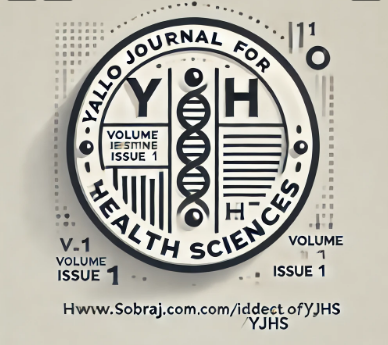Assessing and Identifying Areas of Improvement in Infection Control Practices During Anesthesia
DOI:
https://doi.org/10.5281/zenodo.13331210Abstract
Background: Healthcare-associated infections (HAIs) remain a significant concern in hospitals worldwide, particularly in operating rooms where anesthesia providers play a critical role in infection control. Despite the preventability of HAIs, suboptimal compliance with infection control practices, especially among anesthesia professionals, continues to pose risks to patient safety.
Purpose: This study aims to assess current infection control practices among anesthesia providers in a tertiary healthcare setting and identify areas where improvements are needed.
Methods: A quantitative observational study was conducted in the operating rooms of a large tertiary hospital. Data were collected over two months using a structured checklist evaluating compliance with hand hygiene, use of personal protective equipment (PPE), aseptic techniques, disinfection practices, and segregation of clean and contaminated items. Compliance rates were analyzed using descriptive statistics and comparative analysis across different provider types using chi-square tests.
Results: The study found varying levels of compliance among the evaluated practices. Hand hygiene compliance was relatively low at 68%, while the highest compliance was observed in the use of PPE at 85%. Compliance with aseptic techniques was 74%, and disinfection practices showed a 70% compliance rate. Segregation of clean and contaminated items had a compliance rate of 80%. Significant variability was observed in disinfection practices across different provider types (p = 0.049), with anesthesiologists demonstrating the highest compliance and anesthesia technicians the lowest.
Conclusion: The study highlights critical gaps in infection control practices among anesthesia providers, particularly in hand hygiene and disinfection. The findings underscore the need for targeted interventions, including enhanced education, standardized protocols, and continuous monitoring, to improve compliance and reduce the incidence of HAIs in surgical settings.
References
Biddle, C. (1991). The morbidity and mortality conference: a prolegomenon on its role as an anesthesia risk-management tool. Nurse Anesthesia, 2(4), 165–171. http://www.ncbi.nlm.nih.gov/pubmed/1751572
Biddle, C., & Shah, J. (2012). Quantification of anesthesia providers’ hand hygiene in a busy metropolitan operating room: What would Semmelweis think? American Journal of Infection Control, 40(8). https://doi.org/10.1016/j.ajic.2011.10.008
Birnbach, D. J., Rosen, L. F., Fitzpatrick, M. N., Carling, P., Arheart, K. L., & Munoz-Price, L. S. (2015). Double Gloves: A Randomized Trial to Evaluate a Simple Strategy to Reduce Contamination in the Operating Room. Anesthesia and Analgesia, 120(4). https://doi.org/10.1213/ANE.0000000000000230
Dolan, S. A., Heath, J., Potter-Bynoe, G., & Stackhouse, R. A. (2013). Infection prevention in anesthesia practice: A tool to assess risk and compliance. American Journal of Infection Control, 41(11). https://doi.org/10.1016/j.ajic.2013.06.012
Ecoffey, C., Bosenberg, A., Lonnqvist, P. A., Suresh, S., Delbos, A., & Ivani, G. (2022). Practice advisory on the prevention and management of complications of pediatric regional anesthesia. In Journal of Clinical Anesthesia (Vol. 79). https://doi.org/10.1016/j.jclinane.2022.110725
Fernandez, P. G., Loftus, R. W., Dodds, T. M., Koff, M. D., Reddy, S., Heard, S. O., Beach, M. L., Yeager, M. P., & Brown, J. R. (2015). Hand Hygiene Knowledge and Perceptions among Anesthesia Providers. Anesthesia and Analgesia, 120(4). https://doi.org/10.1213/ANE.0000000000000408
Leite, K. A., Hobgood, T., Hill, B., & Muckler, V. C. (2019). Reducing Preventable Surgical Cancellations: Improving the Preoperative Anesthesia Interview Process. Journal of Perianesthesia Nursing, 34(5), 929–937. https://doi.org/10.1016/j.jopan.2019.02.001
Loftus, R. W., Brindeiro, B. S., Kispert, D. P., Patel, H. M., Koff, M. D., Jensen, J. T., Dodds, T. M., Yeager, M. P., Ruoff, K. L., Gallagher, J. D., Beach, M. L., & Brown, J. R. (2012). Reduction in intraoperative bacterial contamination of peripheral intravenous tubing through the use of a passive catheter care system. Anesthesia and Analgesia, 115(6). https://doi.org/10.1213/ane.0b013e31826d2aa4
Loftus, R. W., Koff, M. D., & Birnbach, D. J. (2015). The Dynamics and Implications of Bacterial Transmission Events Arising from the Anesthesia Work Area. In Anesthesia and Analgesia (Vol. 120, Issue 4). https://doi.org/10.1213/ANE.0000000000000505
Loftus, R. W., Koff, M. D., Burchman, C. C., Schwartzman, J. D., Thorum, V., Read, M. E., Wood, T. A., & Beach, M. L. (2008). Transmission of pathogenic bacterial organisms in the anesthesia work area. Anesthesiology, 109(3). https://doi.org/10.1097/ALN.0b013e318182c855
Loftus, R. W., Muffly, M. K., Brown, J. R., Beach, M. L., Koff, M. D., Corwin, H. L., Surgenor, S. D., Kirkland, K. B., & Yeager, M. P. (2011). Hand contamination of anesthesia providers is an important risk factor for intraoperative bacterial transmission. Anesthesia and Analgesia, 112(1). https://doi.org/10.1213/ANE.0b013e3181e7ce18
Martin, L. D., Kallile, M., Kanmanthreddy, S., & Zerr, D. M. (2017). Infection prevention in pediatric anesthesia practice. In Paediatric Anaesthesia (Vol. 27, Issue 11). https://doi.org/10.1111/pan.13252
Martin, L. D., Martin, L. D., Rampersad, S. E., Geiduschek, J. M., Zerr, D. M., & Weiss, G. K. (2013). Modification of anesthesia practice reduces catheter-associated bloodstream infections: A quality improvement initiative. Paediatric Anaesthesia, 23(7). https://doi.org/10.1111/pan.12165
Morris, A. J., McAvoy, J., Dweik, D., Ferrigno, M., MacArio, A., & Haisjackl, M. (2017a). Cancellation of elective cases in a recently opened, tertiary/quaternary-level hospital in the middle east. Anesthesia and Analgesia, 125(1), 268–271. https://doi.org/10.1213/ANE.0000000000002104
Morris, A. J., McAvoy, J., Dweik, D., Ferrigno, M., MacArio, A., & Haisjackl, M. (2017b). Cancellation of elective cases in a recently opened, tertiary/quaternary-level hospital in the middle east. Anesthesia and Analgesia, 125(1), 268–271. https://doi.org/10.1213/ANE.0000000000002104
Plemmons, M. M., Marcenaro, J., Oermann, M. H., Thompson, J., & Vacchiano, C. A. (2019). Improving infection control practices of nurse anesthetists in the anesthesia workspace. American Journal of Infection Control, 47(5). https://doi.org/10.1016/j.ajic.2018.12.009
Sharma, A., Fernandez, P. G., Rowlands, J. P., Koff, M. D., & Loftus, R. W. (2020). Perioperative Infection Transmission: the Role of the Anesthesia Provider in Infection Control and Healthcare-Associated Infections. In Current Anesthesiology Reports (Vol. 10, Issue 3). https://doi.org/10.1007/s40140-020-00403-8
Shibamura-Fujiogi, M., Ormsby, J., Breibart, M., Zalieckas, J., Sandora, T. J., Priebe, G. P., & Yuki, K. (2021). The Role of Anesthetic Management in Surgical Site Infections After Pediatric Intestinal Surgery. Journal of Surgical Research, 259. https://doi.org/10.1016/j.jss.2020.10.015
Downloads
Published
How to Cite
Issue
Section
License
Copyright (c) 2024 Bayan Qaddumi

This work is licensed under a Creative Commons Attribution 4.0 International License.
The journal is licensed under a Attribution 4.0 International (CC BY 4.0).
Journal Hosting, Support, and Customization by | OJS-Services.com


